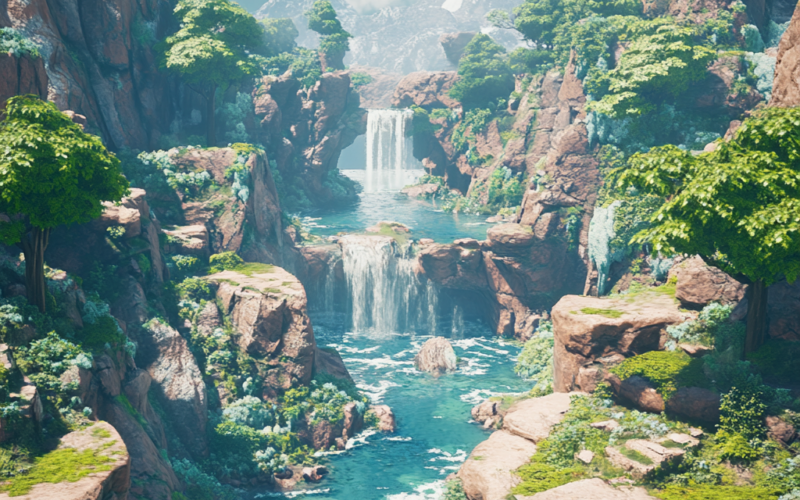The role of landscape in shaping the gaming experience
The landscape in games plays a key role in creating atmosphere and enhancing the feeling of the gameplay. Properly designed landscapes not only increase visual appeal, but also influence the player’s perception of the world. The space in which events take place shapes not only aesthetics, but also mood and motivation. The place where the plot develops can be dark, joyful, exciting or scary, and it is the landscape that sets these tones.
In addition, competent landscape design helps the player understand the goals and objectives of the level, facilitating orientation and subconsciously directing his actions. A well-designed landscape can tell the player where they are and what obstacles await them through the use of symbolism or textures. Spatial decisions play a role in conveying information without the need for further explanation through dialogue or prompts, greatly improving gameplay experience and engagement.
Visual elements: how the landscape affects the perception of the level
Visual elements of the landscape, such as textures, lighting, and color palette, play a critical role in creating the overall feel of a level. Dark shades and dim lighting create an atmosphere of mystery or tension, while bright and warm colors enhance feelings of joy and comfort. Lighting, in particular, can serve not only an aesthetic purpose, but also a functional one, highlighting important elements or indicating the path to be taken.
In addition, the variety of textures allows not only to improve the appearance, but also to subconsciously communicate to the player about the type of environment. Stone textures can hint at ancient ruins, while green areas and grasses can create an atmosphere of wildlife. Visual elements of the landscape activate the player’s emotions, directing his perception in the right direction, and the use of different textures and lighting helps create the necessary atmosphere that will best suit the theme and goals of the level.
Space zoning: using the landscape to organize the gameplay
The zoning of landscape space plays an important role in how the player perceives and interacts with the game world. Clearly defined areas create a sense of order and organization, and also allow players to navigate the space. These zones can be themed, such as forests, mountains or ruins, or functional, separating different stages of the game. Each section of the landscape can be designed to prepare the player for the next part of the adventure or to introduce a new level of difficulty.
Using terrain for zoning also allows for the integration of additional gameplay elements, such as hidden objects or challenges. For example, creating narrow passages or high mountain peaks can not only make the level physically difficult to navigate, but also create natural barriers, motivating the player to find workarounds. Zoning not only helps to structure the space, but also creates a dynamic game where every corner has its own meaning.
Dynamics of landscape changes: creating interesting transitions between levels
The dynamics of landscape change is a process of gradual or abrupt changes that makes the player feel that he is not just traveling through the same types of locations. Transitions between levels, changing weather conditions, or changes in the time of day can significantly affect the perception of the game world. For example, going from a sunny forest to a dark, rainy plain adds drama and changes the feel of the game.
This process can serve both for aesthetic pleasure and for plot progression. For example, a player might walk through a dense forest where every step has a special sound, and then end up in a desert where silence reigns. Such changes are not only visually exciting, but are also accompanied by new game mechanics, adding variety to the process. Dynamic changes in the landscape create the feeling that the world lives its own life, which makes it more interesting and deep.
Interaction between terrain and game mechanics: enhancing gameplay through the environment
The landscape and game mechanics must work closely together to create a fun gameplay experience. Terrain can influence gameplay by determining what actions the player can perform. For example, slippery surfaces or mountains may require the player to use certain skills or tools, adding elements of strategy and crucial choices. The terrain can guide the player through patterns or obstacles, such as rivers or chasms, which can be overcome using skills or specific objects.
This interaction between terrain and mechanics helps create not only visually appealing levels, but also strengthens the gameplay experience. For example, certain landscape elements can create hiding spots or locked areas that require the player to solve puzzles or find alternative paths. This creates a deeper experience where the environment influences the player’s actions and adds meaning to every choice.
Psychology of perception: how landscape elements affect players’ emotions
The landscape in games has not only visual significance, but also has a strong impact on the emotional perception of the player. Each element of the environment – be it color, lighting or textures – can evoke certain feelings, such as fear, anxiety or peace. These elements are used by the developers to enhance the atmosphere of the game and create the right mood throughout the entire gameplay. The psychological perception of the landscape plays an important role in how players react to what is happening and how they interact with the game world.
The influence of landscape elements on the player’s emotions
- Lighting and shadows create atmosphere. Dark and shady areas cause anxiety, light areas cause calm.
- The color palette can influence the perception of space, for example, cold shades enhance the feeling of loneliness or danger, and warm shades – coziness.
- The textures and shapes of objects, such as rocks or ruins, can evoke feelings of grandeur, mystery, or destruction.
- The dynamics of landscape changes affect emotions, for example, the transition from bright to dark locations can create contrast and increase tension.
- Sound in the landscape (for example, the sounds of wind, water or footsteps) also plays an important role in creating an atmospheric effect and perception of the surrounding world.
Thus, landscape elements not only serve as a backdrop for the action, but also actively influence the emotional perception of the game. Proper use of the landscape helps not only to attract the player’s attention, but also to involve him deeper in the gameplay, creating a unique atmosphere that remains in the memory.
Questions and answers
Answer 1: The landscape creates atmosphere, mood and helps the player navigate the space, which affects his perception of the level.
Answer 2: Lighting, textures and color palette affect the perception of the level, creating the desired mood and atmosphere.
Answer 3: Space zoning helps structure locations and highlight different stages of the game, which makes navigation easier and improves gameplay.
Answer 4: Changes in landscape, such as transitions between levels or changes in weather conditions, add variety and keep the player interested.
Answer 5: Terrain influences game mechanics by creating obstacles or providing new opportunities for problem solving and strategy.

